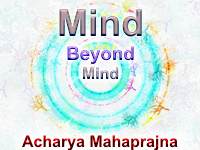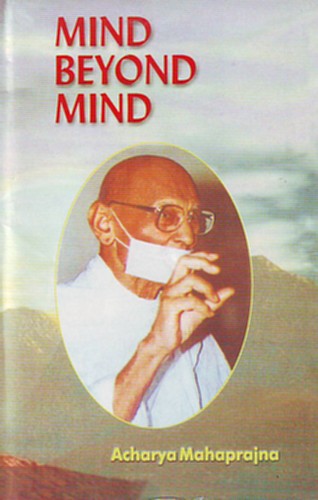
Normally we do not remain within the domain of seeing and knowing, but become bound by attachments and aversions, which keep us away from the soul. Take an example. It is one thing to see and know a flower. It is quite another thing to become attached to its beauty and fragrance. This attachment removes us from the act of seeing and knowing and drops us into the domain of the mind. We can neither see nor know the flower with the help of the mind. It is only by seeing and knowing freed from all kinds of attachments that we can realize the soul. It is only by raising ourselves above the limitations imposed upon us by language that we can get a glimpse of the soul, which ushers us in a state of the cessation of thinking. You cannot but see the soul in a state of thoughtlessness.
Pindastha Dhyana is the practice of concentrating the mind on the body. The object of Padastha Dhyana is the word. Rupstha Dhyana means concentration on form. There is a fourth variety of meditation, which is called Rupatita Dhyana. It leads the practitioner above forms and dispositions. In this state there is no object to be meditated upon. Meditation, which implies thinking, is simple meditation. A state of thoughtlessness is called Samadhi (ecstasy).
There are two terms in Jain philosophy, Dhyana and Samayika. The latter is a kind of meditation. In ordinary meditation we require an object or a symbolic image. The meditator remains distinct and separate from the object he is meditating on. Besides the subject and the object, there is a third element also which is the act of meditation. The practitioner has got to be told what he is to meditate upon. The object may be the sound Arham or any symbolic form or word. The object has to be located first. However, this location is not relevant to thoughtless meditation in which the distinction between the meditator, the object of meditation and the act of meditating is absent. It is an indivisible state. The term Samayika is formed from the term Samaya, which means the soul. In Samayika meditation the soul exists in its own right without anything else to refer to. It is the state of pure Being in which the process of becoming comes to an end. Samayika means to be in the soul or self. One who has entered in the soul leaves the state of meditation behind. He has not to meditate but to be in the soul, which is his true existence. This is a state of complete thoughtlessness. He who has arrived at this state simply perceives and knows nothing but the soul. The self-contradictory process of thinking continues only until this state has been realized and then ceases. It is better if we use the term Samayika instead of the term meditation. Mahavira used this term only.
How can we achieve the state of thoughtlessness? No straight answer is possible. Only a misleading and confusing answer can be given. The question is an intellectual question about some thing, which is beyond the reach of the intellect. One has to do a lot of hard thinking and heart searching before he can get a straight answer. Probably there can be no answer. No living being who has a body, mind and intellect can attain a state of thoughtlessness, just as no being who is subject to attachments, illusions etc. can get freedom from miseries. This is a very important fact to note. The state of thoughtlessness can be attained only by exertion. And yet the question is natural and one is very often tempted to expect a straight reply. The state can be achieved only through a dedicated life.
It is a fact that too much thinking results in loss of energy. As a matter of fact, all kinds of activity produce a de-energising process and tire the mind and the body out. Those who do intellectual labour suffer from diseases of the stomach. Thinking is no doubt the function of the brain, but it has its own limitations. To go beyond limits is harmful.
Thoughtlessness is not the function of the body even. It is not concerned with words and forms. It is the nature of the self, and therefore, it involves no loss of energy. On the other hand, it produces additional energy in the body and the mind. Thinking causes loss of energy, which has got to be compensated in order that we may be able to think more. Thoughtlessness needs no organic energy. It is a natural state of the soul where there is no need of receiving any kind of energy from outside. There is a profuse outburst of energy in this state. It produces comprehensive knowledge, which cannot be attained by thinking.
The first thing we need in connection with the attainment of a state of thoughtlessness is patience. We should first fix a target and begin with the concentration of the mind. Once a sufficient progress has been achieved in getting free from likes and dislikes, we will be able to develop the capacity to see and know. At this stage we will be able to appreciate the idea of thoughtlessness.
Perception and thinking cannot go together. One who thinks does not know and one who knows does not think. Reflection and contemplation are mechanical activities of the mind. Perception and knowledge, on the other hand belong to a different order. They are natural activities of a unified consciousness. Undifferentiated consciousness is the characteristic of the self. We have to dive into the depths of consciousness in order to perceive and know. This diving may prove to be dangerous and requires great courage. We need courage even to die in search of truth. As a matter of fact truth can be achieved only by those who are gladly prepared to die. Quite a few practitioners lose courage as soon as they have entered into a state of thoughtlessness and break off.
Acarya Bhikshu was a great practitioner. In order to achieve his aim he first all began to prepare himself to die. No body who is not prepared to die can get on the right track. The true practitioner neither longs to live, nor does he fear death.
Words do affect meditation. But they become ineffective in a state of thoughtlessness. They may give twists and turns to the process of meditation. The practitioner in the state of thoughtlessness is not disturbed by ideas and thoughts. Love of one's body, longing for life and the fear of death do not trouble him any more. He enters in a state of total unattachment and becomes committed only to the self. He transcends all kinds of attractions and sheds every kind of burden from his shoulders. He cuts across the gravitational field of worldly life and achieves a state of weightlessness.
 Acharya Mahaprajna
Acharya Mahaprajna

